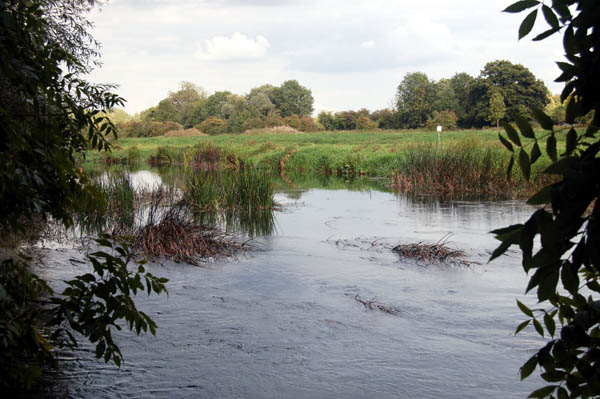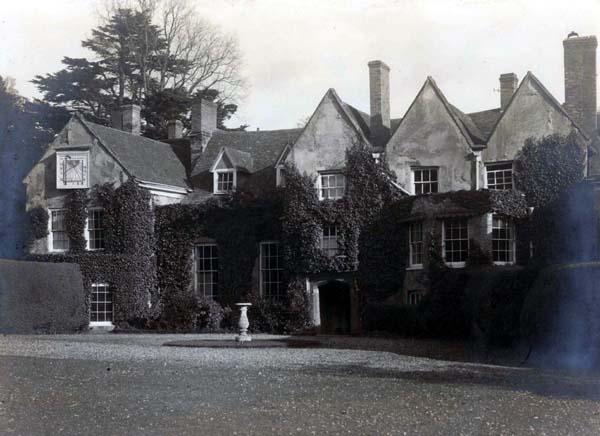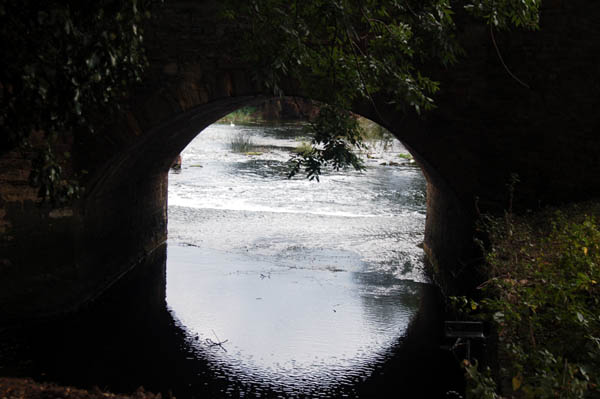Introduction

River Great Ouse at Bromham Bridge - Sep 2007
Name
Bromham is an ancient parish, first recorded in the Domesday Book of 1086, it lay in the Willey Hundred. The name probably means Bruna's homestead and was first recorded as Bruneham with other variants including Bruham (1164-1302), Braham (1227), Bramham (1228), Brumham (1262-1287), Brunham (1276-1291), Brumbham (1276), Brynham (1276), Broham (1278), Bronham (1338), Broam (1360), Brounham (1361) and Burnham (1361). The modern spelling is first recorded in 1227.
Geography
The parish is somewhat like a flattened and distorted cross in shape and contains 1,827 acres (about 730 hectares) and varies in height above sea level from 222 feet in the south west down to 109 feet in the south. The River Great Ouse forms most of eastern parish boundary from a point just south of Oakley House in a wide arc to a point just south-east of The Paddocks. Neighbouring places are Stevington (north-west), Oakley (north), Clapham (north-east), Bedford (east), Biddenham (south-east), Kempston Rural (south) and Stagsden (south-west).
The soil is divided between sand in the west and clay in the south. Before the bypass of the 1980s Bromham lay on the main road from Bedford to Oakham in Rutland, now known as the A6.
In recent years Bromham has seen huge growth with the building of large housing estates in the south and, to a lesser extent, north and west of the parish. Another development has taken place on the site of the former Bromham Colony (a residential home for people with mental handicap which closed at the turn of the 20th and 21st centuries). The large amount of land almost encircled by the river in the east of the parish remains, as yet, undeveloped.
Domesday
The Domesday Book of 1086 records that Bromham was held by a number of people and there are a number of unusual features about the parish (which lay in the Hundred of Willey) as will be seen from the following. The largest landowner was Hugh de Beauchamp who, within ten years would be created Baron of Bedford. He held 6 hides and his tenant was one Serlo of Rots. In 1066 the land had belonged to Alfsi of Bromham, a retainer of Edward the Confessor's Queen, Edith. It had then been worth £4, unusually the value had risen to £5 by the time Hugh acquired it and had risen further to £7 by 1086 (most Bedfordshire manors had lost in value due, historians consider, to the depredations of William I's armies as they moved north to crush rebellion). Hugh's manor contained 16 villagers, 5 smallholders and 6 slaves as well as a mill worth £1 and 125 eels and woodland for 40 pigs.
Countess Judith owned a further 2 hides, of which Hugh de Beauchamp was tenant. The manor included 5 villagers and 2 smallholders as well as a mill worth £2 and 100 eels which was "of the Countess' Holding, but it does not lie in this land". This land had been in the tenure of Godwin, a thegn of Earl (later King) Harold in 1066 when it was worth 10 shillings; again, by 1086 this had risen in value, in this case to 20 shillings.
Count Eustace held 1½ hides and his tenant was Arnulf of Ardres (a town near Calais). In 1066 the land had been held by Alfwold and Leofric from King Edward the Confessor., Then it had been worth 20 shillings, which was still its value when Eustace acquired it but by 1086 this value had been halved. A further minor landowner was Osgeat, who had a virgate and two parts of a further virgate. Again, unusually, he had held this land in 1066 (often native Anglo-Saxons were deprived of their land for it to be given to Normans or other foreign retainers of William I); it had then been worth 5 shillings and, by 1086, was worth 10 shillings.

Manors
Original Bromham Manor
Bromham Manor was the land owned by Hugh de Beauchamp at Domesday and it remained in the family until the death of John de Beauchamp at the Battle of Evesham in 1265, when it was held by his mother Amicia and, on her death in 1278, it was divided between John's three sisters Maud, Ela and Beatrice.
Manor of Brayes, also called Bromham Manor
The Manor of Brayes, also simply known as Bromham Manor, was that part of John de Beauchamp's Bromham Manor which passed to his sister Maud in 1278. Her first husband was Roger Moubray and his grandson, John, inherited the manor which remained in the Moubray family until 1488 when it was acquired by Sir Reginald Bray, remaining in that family until 1565 when it was sold to Sir Lewis Dyve who already owned two manors in the parish. The manor remained in the Dyve family until 1645 when the estates of Sir Lewis Dyve, who had been a prominent supporter of King Charles II, were sequestered by Parliament. Sir Lewis was imprisoned in the Tower of London. The manor remained in the family until sold to Sir Thomas Trevor, Chief Justice of Common Pleas, in 1708. He became Baron Trevor of Bromham in 1712 and died in 1730, succeeded by his eldest son Thomas, who died childless in 1754 and was succeeded by his brother John. He also died without having produced a son and his half-brother Robert inherited his lands who, in order to comply with the will of his maternal great-grandfather, changed his name to Hampden, being created Viscount Hampden in 1776.
Viscount Hampden died in 1783 and was succeeded by his eldest son Thomas Trevor Hampden and, when he died childless in 1824, the manor passed to his brother John Trevor, 3rd Viscount Hampden. When he died in the same year, his will devised the manor to his kinsman George Rice Rice, who became Fourth Baron Dynevor in 1852 when his estate passed to his daughter Miss Rice Trevor and, on her death, the manor descended to her great-nephew Trevor Wingfield who was Lord of the Manor into the 20th century (all manorial incidents, courts and tenure of land being abolished under the Law of Property Act 1922).
Wakes Manor
Wakes Manor originated in the third share of Bromham Manor inherited by John de Beauchamp's second sister Ela, wife of Baldwin Wake. Ela herself had three daughters Ida de Steyngreve, Elizabeth de Hoobury and Joan Picot, who each inherited a third of this manor.
Ida's third share descended to her daughter Isabel, who was succeeded by her son John de Patishull. He also inherited half of Elizabeth de Hoobury's third share on her death in 1314, thus making his third share of the manor into a half share. John's son William died in 1360 and left his third share of Wakes Manor to his sister Alice, wife of Thomas Wake. The Wake family held half the manor until at least 1458 but by 1526 it was owned by Nicholas, Lord Vaux, whose son Thomas sold it to Sir Lewis Dyve in 1555.
Joan Picot's third share passed to her brother-in-law John Picot on her death. He had also inherited half of Elizabeth de Hoobury's third share in 1316. The half share of the manor remained in the Picot family until the fifteenth century when it passed to the Dyve family. Sir Lewis Dyve had purchased the Wake family's half share of the manor in 1555 and at some point purchased the Picot family's half share as, by 1565 he was stated to own the whole of Wakes Manor, which then followed the same ownership as Brayes Manor above.
Second Bromham Manor
This third part of Bromham Manor was the share of John de Beauchamp's youngest sister Beatrice who passed it on to her daughter Maud de Botetourt on her death. The manor seems to have continued to be known as Bromham Manor. It then passed through the Latimer family, then the Nevill family of Raby [Leicestershire] until 1577 when Lucy Cornwallis, daughter of John Nevill inherited it. The Cornwallis family alienated the manor to William Boteler. The manor is not mentioned in surviving records after 1612, perhaps because it simply became part of the Boteler's larger manor in Biddenham.
Bowels Manor
This manor may have its origin in the two hides Hugh de Beauchamp held from Countess Judith in 1086. The earliest known holders of this manor are the Passelowe family in 1280. William Passelowe conveyed it to Richard de Ruthyn in 1326 and by 1346 he had conveyed it to Ralph Butler and it remained in this family until 1551 when John Butler alienated it to Robert Odell. Two years later Odell conveyed it to Sir Lewis Dyve and its later history mirrors that of the manors of Wakes and of Brayes.

Medieval murder
Volume XLI of Bedfordshire Historical Records Society series is a series of translations by R.F.Hunnisett of medieval coroner's rolls for the county, entry 123 reads: "In the early night of 25 Feb 1272 Ralph son of Ralph vicar of Bromham went into the road opposite the east end of Bromham church towards William Passeleuwe's house [i.e. Bowels Manor?]. Robert Bernard of Wootton, Robert of Shefford, Richard Norman and Roger Brien [later stated as, of Bromham, carpenter] came, and Robert Bernard asked Ralph who he was. He replied: a man, who are you? Thereupon Robert, because he was drunk, sprang forward and struck Ralph across the crown of the head with a "spart" axe, giving him a wound 5 inches long and through the middle of the bone in depth, so that blood and brains immediately flowed out, he immediately lost his speech and died thereof about midday on the morrow". An inquest was held at which the people from Bromham said that Robert Bernard alone was identified as the killer, he had come from Robert Malyn's tavern. The people from Biddenham disagreed, saying that Robert was the killer but the others "consented to do any other misdeed and were waiting to do injury to someone else there". Those attending from Stagsden and Stevington said the same, implying that these men might well have been well known locally as troublemakers. As a result of this all the other members of the gang were arrested too.
At this time clergy were supposed to be celibate but Ralph had a wife named Agnes and she went to the County Court in March of that year to appeal [i.e. accuse] the men held responsible for her husband's death. Her statement added the detail that Ralph was assaulted at the crossroads of the road from the courtyard of William Malerbe to the Vicarage and a road from the east side of the churchyard to William Passeleuwe's house. She further accused Robert of Shefford of striking Ralph with a "denesch" axe "on his loins, breaking them, of which blow he could have died if he had not died of the first wound". She also accused Robert Norman of hitting him with a wooden staff called a "clobbe" on his left side, breaking two ribs "of which he would have died if he had had no other blow". Furthermore Roger Brien hit him between the shoulder blades with an oak "clobbe" "of which he would have died had he had no other blow". Agnes also accused the innkeeper, Robert Malyn and Malina, his wife, of harbouring the felons. The text reveals that Ralph and Agnes has a son, William.
Agnes went to court three times more to make the same accusation but each time those accused failed to attend. Robert Bernard was outlawed because no one would fine surety for him. The others involved found people to be their sureties, all bar one people of Stagsden, again implying the people were well known in the district. Eventually Malyn and his wife along with Richard Norman attended court and were gaoled whereas Robert of Shefford and Roger Brien never did and were outlawed. The last that records mention of the case is that at the Eyre (the court held locally by judges travelling around the country from Westminster) no one knew of any goods or chattels of Bernard, Shefford or Brien "because they were strangers"; the others were once more committed to prison. Alice, for some reason did not attend the eyre to sue those in prison and so she, too, was arrested and fined and Norman, Malyn and his wife went free.

Bromham Mill Sep 2007
Population
The population of Bromham at Domesday was 21 villagers, 7 smallholders and 6 slaves - a total of 34. To arrive at a real figure one probably needs to multiply this number by at least four to allow for dependants - giving a total of around 136 - quite a large settlement by the standards of the time. The population of Bromham today is out of all proportion to its historical size as the following figures demonstrate:
1801: 297 1851: 343 1901: 321 1951: 1,220 2001: 4,765
The largest jump in population was in 1951 when numbers rose 276% from the previous census in 1931 (there being none in 1941 due to World War Two).